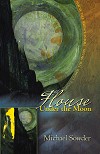Michael Sowder. House Under the Moon. Truman State University Press. 2012. 85 pgs. $15.95.
Reviewed by Lynn Domina
Of course I would pick up a collection of poetry whose opening poem is titled “Lectio Divina.” And of course I would look at it more closely once I noticed the titles of some other poems: “When God wakes up inside you,” “Hiking at Oselong, Tibetan Buddhist Monastery of Andalucía,” “Fire Sermon,” and “Pierre Teilhard de Chardin Cut-up.” Whether or not I would end up truly admiring these poems, I knew that the chances were good I’d find something to appreciate. House Under the Moon, Michael Sowder’s second collection, is accomplished and compelling. Its mood is meditative, yet a story emerges as the poems accumulate. Through them, Sowder explores and reveals his spiritual engagement, yet his language is concrete. The transcendent in this collection is fully integrated with the immanent.
The book is organized into two sections, “Homecoming” and “Housekeeping.” The first section is set earlier and includes several poems that feature his first son, Aiden; the second is set a few years later and focuses more on his second son, Kellen. In both sections Sowder addresses the divine; the poems suggest that the speaker, his sons, and other people participate in divinity by whatever name it is known.
The first poem, “Lectio Divina,” opens with a common object put to a task that is no longer so common: “With my mother’s pitted paring knife / I slice the yellow, uncut pages.” The pages are from La Vida de Santa Teresa de Jesus, or the autobiography of Teresa of Avila. The speaker immediately recognizes a kindred voice, one he had known as a younger man. The final stanza suggests how closely we are each connected to the saints, just as each of our solid forms is buoyed up within impermanence: “Or is it the way I’ve found my / dawn cries lifted, sung / by a woman, an Atlantic / away, centuries ago, in a convent / of barefoot nuns, a town of stone and light, / in a book I’ve called from a warehouse, / acids hurrying it to dust, pages / never cut open until now? / O, Santa Teresa, / may your words that I am breathing, / in this slow disappearing, / light my way to Avila.” I am personally taken with this poem for its recognition of literature’s ability to dispel our cosmic loneliness, for it shows us that others too, though worlds away, have felt as we feel and thought as we think. Who could be more different from the speaker than a 16th century Spanish cloistered nun? Teresa was a mystic, however, and so is the speaker, as later poems will reveal. The poem succeeds, though, because of its craft. The line breaks enhance the meanings of the sentences; the speaker’s cries are “sung / by a woman” and also, due to the lineation, by “an Atlantic.” The speaker, therefore, is linked not only through time to other mystics but also to the expansive world itself. When Avila is described as “a town of stone and light,” we understand it as a place of permanence and revelation, as Teresa’s words seem to have acquired another kind of permanence for those of us who read them centuries later. Yet the words too are disappearing, in part because the paper they’re printed on is literally disintegrating, but also because we all disappear, “hurrying…to dust.” “Lectio Divina” is the perfect poem to open House Under the Moon because it so successfully links the two primary spiritual traditions explored in this collection—Christianity and Buddhism. The Christianity is obvious in this poem; as it concludes, however, we move toward a more Buddhistical interpretation of existence, a focus on impermanence. As a prayer form, lectio divina is a practice of meditative reading, usually of scriptural texts—but many of the poems in this collection also reward meditative attention.
Several of the poems here explore similar themes, often by revealing the speaker’s care for his sons. In “Kellen in My Lap, Five Months Old,” the speaker has risen in the middle of the night to hold his son. Reading Zen Mind, Beginner’s Mind while his son sits on his lap, the speaker considers enlightenment: “What is satori? Suzuki asks. The bottom of a pail / broken through.” Meanwhile, the speaker’s infant son plays with his fingers as light and darkness mingle inside and outside: “Darkness / holds its wing above the valley. Orion // brightens January snow and down in the far fields / flickers a single yellow windowpane. // The delight you find in my fingers / a monk has no words to name.” The yellow light outside recalls the “circle of lamplight” by which the speaker is reading in the opening line. Again, the images carry the poem through to its conclusion so that Sowder can conclude with a direct statement, one that is nevertheless tonally consistent with the lines that have come before.
House Under the Moon succeeds primarily because so many of the individual poems are so accomplished. The collection as a whole also demonstrates Sowder’s ability with multiple strategies and forms—couplets, prose poems, irregular stanzas, justified and indented lines. Even as the poems explore a consistent theme, Sowder keeps the reader engaged through stylistic variety. I found this book refreshingly honest. It’s a collection that invites us in—to observe not only a mind thinking, but a mind emptying itself of thought.

